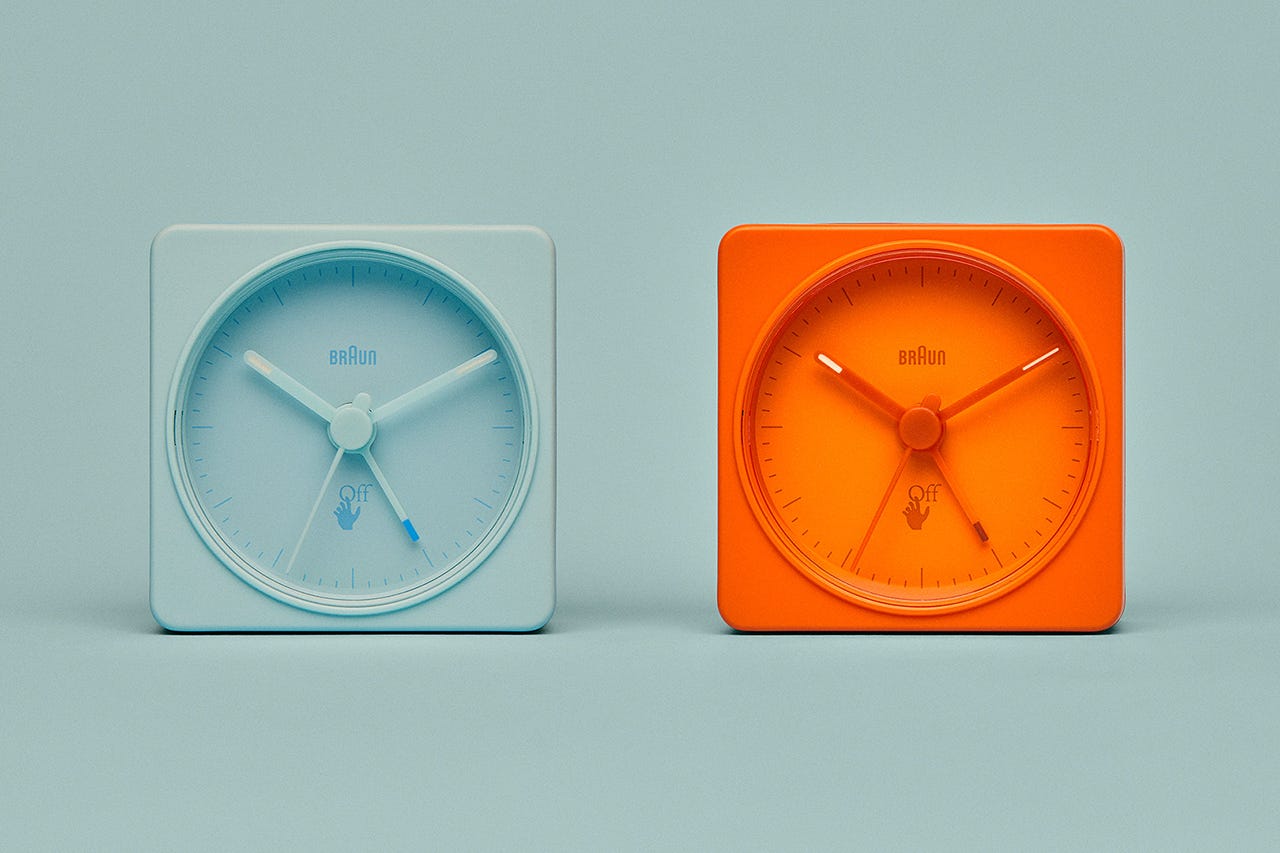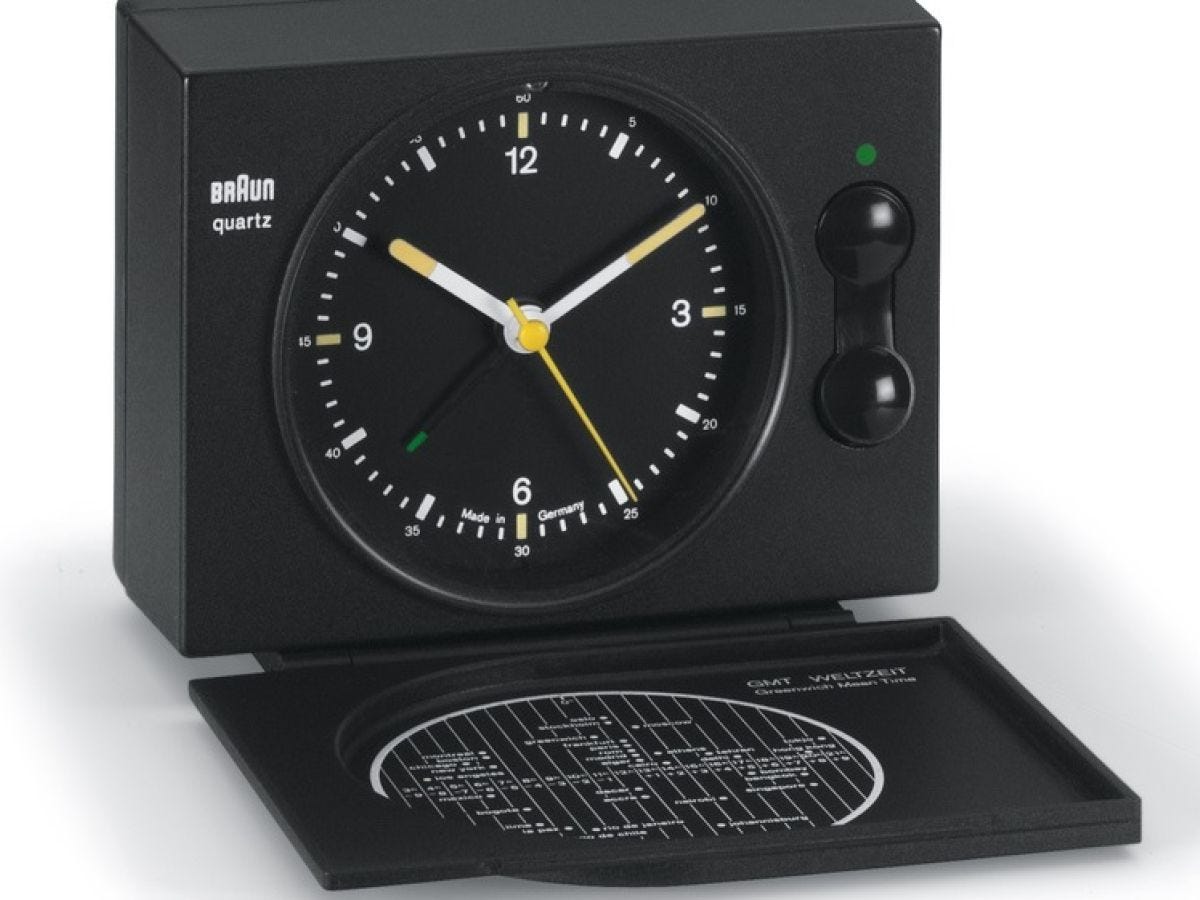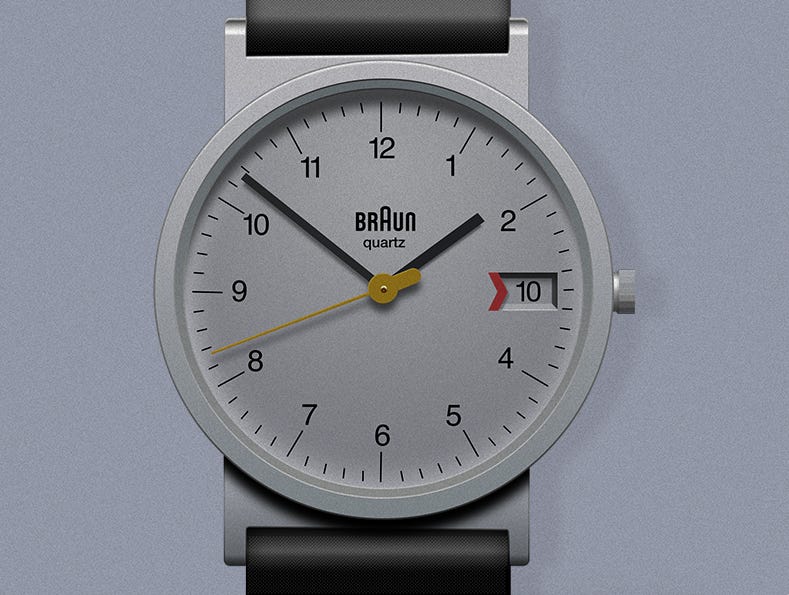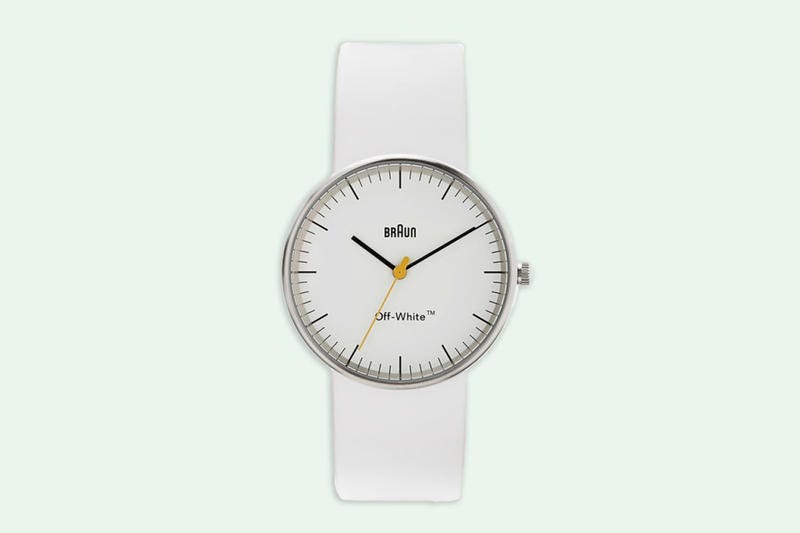Sometimes, I like to head over to <hypbeast.com/watches> to see what’s hot with the kids — as someone in the twilight of his 20s, it’s increasingly difficult for me to understand the youths. On Hypebeast, every post is given a 🔥 hypes number, presumably some arbitrary metric of clicks/engagement. A transparent G-Shock post might have 25k hypes, while Bremont gets a mere few hundred.1
But do you know which watch brand is running up the scoreboard with crazy high hype numbers in 2021?
Braun. Yes, Braun, that same German company that makes the electric shaver you haven’t used since retreating into self-isolation.
Here’s why Braun’s hype, but, if you look just a layer deeper, not.
👉 Rescapement is a weekly newsletter about watches. Subscribe now to get it delivered to your inbox every Sunday.
One email a week, that’s it.
Braun: Turn me on with your electric feel
Braun was founded back in 1921 by engineer Max Braun. He found some success manufacturing radios and record players before World War II, but the company’s Frankfurt factories were basically destroyed in bombings during the War. But, Braun rebuilt his factories after the War and started selling radios again just a few years later.
It’s during this time that Braun’s most iconic product, the electric shaver, was also developed. As the story goes, Mr. Braun himself was prone to shaving his own male employees who apparently would’ve turned to werewolves if not for this prudent intervention, so the dry, electric shaver was developed to solve this “problem.” Around this time, Braun also started manufacturing a variety of kitchen appliances — mixers, food processors, etc. This era at Braun, from the 1950s-60s or so, is the stuff of corporate lore; the type of catnip Silicon Valley types write ‘thought leadership’ articles about, asking whether mid-century Braun or turn-of-the-century Apple was more innovative.
Okay, but what about the watches?
In 1955, legendary designer Dieter Rams joined Braun, becoming the chief designer by 1961, a position he’d hold until 1995.2 Braun ventured into timekeeping in the 1970s, first with the phase 1 and phase 2, small clocks with mechanically-rotating digital displays. Really, it was just designer Dietrich Lubs — with helpful pushes from Rams — working out the kinks, figuring out what clock and watch design for Braun might be. The breakthrough came in 1975.
By 1975, clocks were quartz and not mechanical, allowing design to drive decision-making. For Braun, the result was the brand’s first travel clock, which simply illustrated time zones on the clock’s protective lid.3 It was a massive success.
Soon after, Braun started making wristwatches: its first efforts were digital watches with segmented leather bands, meant to imitate the popular integrated bracelets of the day (see Royal Oak; Nautilus).
In the 1980s, Braun introduced its first analog wristwatch, the AW10. It was a simple three-hander measuring 33m, with Helvetica font and long markers to make it easier to read. Sitting here in 2021, Braun’s pitch almost sounds cliche: among the two-tone and bling of the 80s, we couldn’t find the watch we wanted, so we made it ourselves, where form follows function; minimalist; everything you need, nothing you don’t. Indeed, Braun’s approach inspired legions of watches, some of which are still floating around on the internet, with Instagram ads following you around like Pikachu in the Yellow Version.
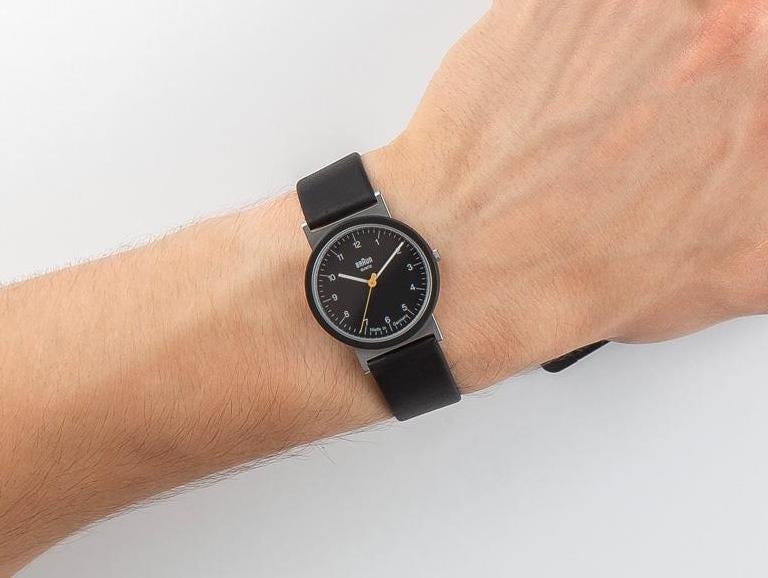
Sure, Braun’s watches were part of a certain trend in the 80s: Swatch, G-Shock, Braun. All simple, cheap, and quartz-powered. But Braun watches stand apart from these two. Swatch was pop art for the wrist, designed to make watches cool again and to get people to care about Swiss Made. G-Shock was the tough, shock-proof watch built for anything. Braun was none of those.
The AW10 was followed by the AW20, which added a date window (read: the best date window of all time?!) to its older sibling’s simple form. Braun, led by Lubs and Rams, would go on to produce a number of references over the years — always quartz, always simple. That’s what made Braun different.
In recent years, Braun has even brought back these original watch designs (with the help of Lubs), upsizing the cases and modifying the designs a bit for modern tastes.
But, Braun’s not only interested in looking back; it’s also focused on the future.
Braun x Off-White
Enter Virgil Abloh. While luxury brands like Patek and Rolex have been adopted by hip-hop and streetwear, it almost feels like that’s happened despite these brands’ best efforts to the contrary. I mean, look at Rolex’s ambassadors page and you’ll still see it boasting of relationships with patrician enterprises like tennis, equestrian, golf, and sailing, while the music page features its relationships with various world-class orchestras and classical composers.4 Could you imagine Bruce Springsteen as a Rolex ambassador, let alone Megan Thee Stallion?
But you can’t say that about Braun.
Braun has gone out of its way to evolve — not only with its own in-house designs, but also by collaborating with hypebeast darlings like Fragment Design, Paul Smith, and Off-White. Abloh and Braun first teamed up in 2016, creating a minimal Off-White x Braun quartz watch that quickly sold out.
Sound the alarm: Braun x Off-White Alarm Clock
While their first wristwatch collab may not have been totally daring, Braun and Off-White’s second effort is a bit more Abloh-ized. Off-White took Rams’ and Lubs’ classic BC02 alarm clock form and dumped some paint on it, making a monochromatic orange or blue designed to stand out.
While Abloh might be best known for customizing rare Pateks and Rolexes for guys like Drake, the Off-White x Braun efforts are decidedly more accessible ($70 for the alarm clock) — not to mention true to the original design, for those wondering how one could possibly deface a Nautilus with green gems and still look at themselves in their Ikea x Virgil “Distortion” mirror.
As it turns out, the alarm clock was just the first in an ongoing collaboration between Abloh and Braun to celebrate Braun’s “100 years of good design”. This week, Abloh put his spin on Braun’s famous Wandanlage hi-fi audio wall unit.
Listen, I don’t care if you love or hate what Abloh’s doing with Braun’s back catalog. This isn’t some hagiography of Abloh — he’s a decent designer, while a master marketer — but it’s hard to deny that tapping into whatever pop culture alchemy he’s harnessed isn’t a bold, brilliant brand move by Braun. It’s encouraging to see the collab starting with watches and clocks, getting people who might only care about Off-White and Abloh to think about these items and how they might fit into their lifestyle in a way they never have before. Start with Off-White, end with vintage White Star, or something like that.
Brains and Braun

But, Braun’s not relying only on Abloh to push its clocks and watches into the future. Earlier this month, Braun released its first automatic watch, the BN0278. It’s a limited edition of 100, again drawing on the historic designs of Rams and Lubs. But at 40mm and with a dark matte stainless steel case, it’s got a certain modern appeal those original designs don’t have.
It’s fascinating to see a brand whose entire ethos boils down to “form follows function” finally produce a mechanical timepiece here in 2021, when time is literally everywhere around us all the time, and mechanical watches have been made obsolete a dozen times over. It prompts the question: what even is the purpose of a timepiece?
Hype and purpose
“What’s compelling about Braun is the ethos of the company is about function and aesthetic,” Abloh says in a video he released with Braun this week. “We all make stuff, the goal is to make it with purpose.”
Of course, the counter presents itself: what purpose does making a new colorway or adding a few gems serve on any of these clocks or watches, Mr. Abloh?
But isn’t that the point? None of this stuff — alarm clock, watch, audio-wall unit — has any purpose anymore. Your phone does it all. So sure, it might be easy to dismiss what Abloh and Off-White are doing as merely feeding hype, with the designer implementing his self-proclaimed “cheat code”, the idea that one can create a successful new design by changing an existing design by just 3 percent.
But look beyond the hype and you’ll quickly find yourself asking questions much deeper, about the purpose of the things we have and the things we want.
Whether it’s a greened-out Nautilus or a simple alarm clock, they’re all ways of expressing who we are and who we want to be — good, bad, and in-between.
👉 For more stories about watches and culture, subscribe to get Rescapement delivered to your inbox every Sunday:
Through the Wire
The Persistence of Memory
⌛ This virtual exhibition from The Hour Glass is awesome. It surveys the last 50 years of artisanal watchmaking, with George Daniels as the launch point. It goes on to feature the work of Journe, Dufour, Voutilanen, and other heavy hitters, up to young upstarts like Petermann Bedat and Rexhepi. From The Hour Glass:
The Hour Glass’ goal with The Persistence of Memory is to create a living online repository of the key members of this contemporary artisanal watchmaking movement, documenting its developmental timeline and photographing and archiving its most important watches.
Just check it out already. Begin with George Daniels and wander the halls of the virtual museum from there.
💎 Philippe Dufour is creating the world’s most expensive jewelry watch. Financial Times’ Nick Foulkes has the story.
🏡 In Chicago: Anyone wanna go in on this Frank Lloyd Wright house for sale in the south suburbs?
Rescapement is driven by referrals and recommendations. A few shares on Instagram, WhatsApp, or wherever else go a long way towards driving its growth. If you like it, share it. Thank you!
For perspective, a new Nike show drop might get 200k hypes. Sorry, Bremont.
The documentary Rams about the man and his impact is pretty solid, if you’re into that type of thing.
Nope, no travel clock jokes down here!
The relationship between luxury, hip-hop, and streetwear is certainly a topic for another day, but all this is merely to point out the contrast between these true luxury brands with Braun’s approach.





